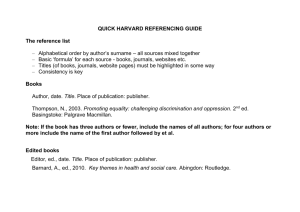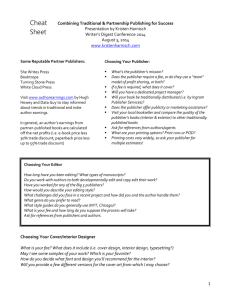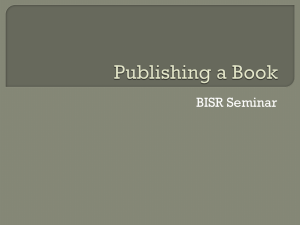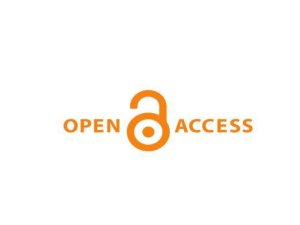OA compliance how publishers can help 20150325
advertisement
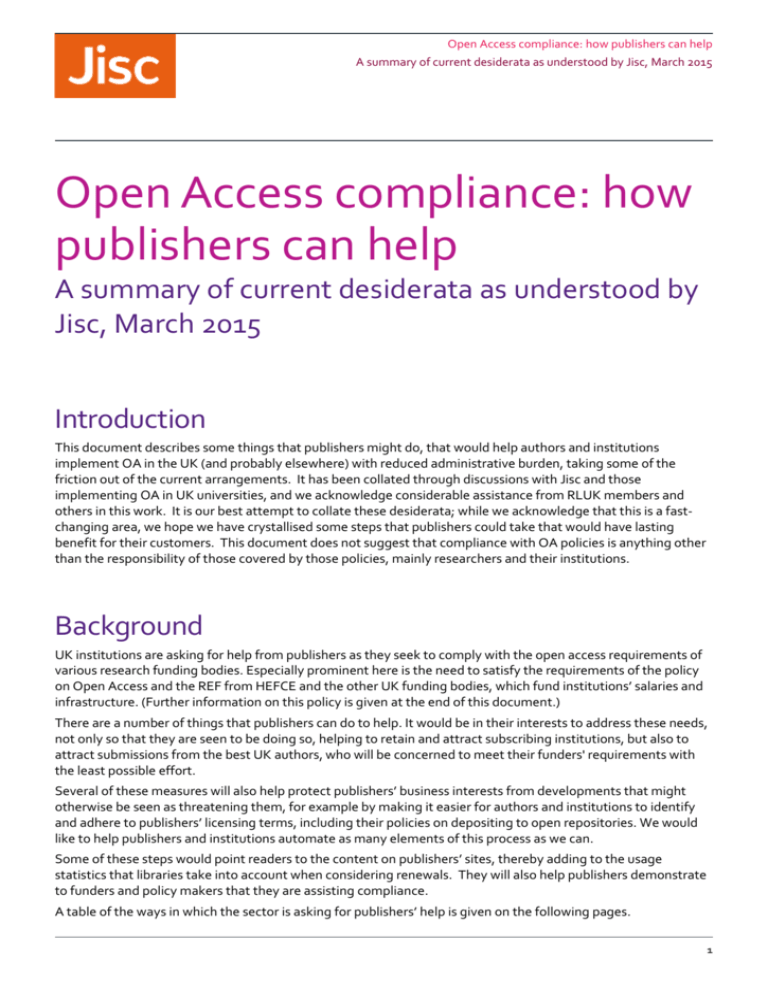
Open Access compliance: how publishers can help A summary of current desiderata as understood by Jisc, March 2015 Open Access compliance: how publishers can help A summary of current desiderata as understood by Jisc, March 2015 Introduction This document describes some things that publishers might do, that would help authors and institutions implement OA in the UK (and probably elsewhere) with reduced administrative burden, taking some of the friction out of the current arrangements. It has been collated through discussions with Jisc and those implementing OA in UK universities, and we acknowledge considerable assistance from RLUK members and others in this work. It is our best attempt to collate these desiderata; while we acknowledge that this is a fastchanging area, we hope we have crystallised some steps that publishers could take that would have lasting benefit for their customers. This document does not suggest that compliance with OA policies is anything other than the responsibility of those covered by those policies, mainly researchers and their institutions. Background UK institutions are asking for help from publishers as they seek to comply with the open access requirements of various research funding bodies. Especially prominent here is the need to satisfy the requirements of the policy on Open Access and the REF from HEFCE and the other UK funding bodies, which fund institutions’ salaries and infrastructure. (Further information on this policy is given at the end of this document.) There are a number of things that publishers can do to help. It would be in their interests to address these needs, not only so that they are seen to be doing so, helping to retain and attract subscribing institutions, but also to attract submissions from the best UK authors, who will be concerned to meet their funders' requirements with the least possible effort. Several of these measures will also help protect publishers’ business interests from developments that might otherwise be seen as threatening them, for example by making it easier for authors and institutions to identify and adhere to publishers’ licensing terms, including their policies on depositing to open repositories. We would like to help publishers and institutions automate as many elements of this process as we can. Some of these steps would point readers to the content on publishers’ sites, thereby adding to the usage statistics that libraries take into account when considering renewals. They will also help publishers demonstrate to funders and policy makers that they are assisting compliance. A table of the ways in which the sector is asking for publishers’ help is given on the following pages. 1 Open Access compliance: how publishers can help A summary of current desiderata as understood by Jisc, March 2015 Desiderata Service we would like Why? Benefit to publishers 1. The publisher undertakes to supply the author’s accepted manuscript (AAM) to the author as an attachment to the acceptance email. This should be in the form that they permit to deposit on an open repository (i.e. already including any disclaimer or other statements that they require under these circumstances). To prompt author to upload to Correct version. Helps ensure that any institutional repository (IR), or to ask version deposited by the author(s) on a IR staff to do so. repository is the one that the publisher’s policy allows, and that any publisher To ensure all co-authors are also disclaimer is included. prompted and are aware of date of acceptance. If publisher adds CrossMark (or other links back to publisher site) to AAM, ensures To save IR staff time in investigating these are included in the version deposited, details of acceptance date. Ideally, it should be emailed to all authors, helping to increase traffic back to To help ensure correct version is not just the corresponding author. Failing publisher site. deposited (AAM as opposed to earlier that, the letter should ask the corresponding author versions). author to forward it, together with the attached AAM, to the other authors. 2. The publisher commits to deliver a copy of To help institutions to comply with the AM at or near acceptance to a Jisc service REF OA policy as efficiently as (such as Jisc Publications Router) that helps possible. institutions comply with the REF policy, subject only to limitations in their current technical systems, which nonetheless they commit to make reasonable efforts to try to address. The best UK authors are more likely to submit their best papers if they can be confident that the publisher is actively helping them to comply with the REF stipulations, and so they don't need to worry about depositing onto their repository themselves. 3. The publisher registers the article’s DOI upon To enable recording of DOI of AAM acceptance, and informs all co-authors. deposited upon acceptance, to facilitate deduplication e.g. with later updates from various sources upon publication. If authors can include a DOI with the AAM they deposit, then the DOI is more likely to feature in the repository metadata and so more likely to drive traffic to the publisher site. Possible future potential to enable notification of acceptance? Introduction 2 Open Access compliance: how publishers can help A summary of current desiderata as understood by Jisc, March 2015 4. Service we would like Why? Benefit to publishers The publisher should ensure that the acceptance letter to the author should include a clear statement on what the author may do with the AAM – that is, the terms under which it may be deposited and made publicly available, including any embargo period and the license that then applies to the AAM. This should include details of how the AAM may be (re-) used. Providing this authoritative In conjunction with previous point (sending statement at acceptance will save acceptance letter to all authors), helps staff time at the author’s institution in ensure publisher's policy (on deposit to IRs) searching for and interpreting any is transmitted accurately to all authors, so policy on the publisher’s web site, a that any deposit is more likely to adhere to time-consuming task. publisher's terms. It will also provide clarity for the authors themselves. 5. The publisher ensures that its embargo To ensure all outputs can comply with The best UK authors are more likely to periods are no more than those set out in the REF policy. submit their best (and therefore most REF policy. citable) papers if they can be sure they can comply with the REF stipulations, and so be eligible for submission to the next REF. 6. The publisher should ensure clarity of overall To enable authors to make informed licensing/policy position (at the journal level) choice of journal based on what for each version (AM, VoR…) including any journals permit. embargos for each. To enable repository staff & Sherpa Use of standard terminology/ definitions in RoMEO to give informed advice publisher policies/ licences. about whether a given journal complies with a given funder's Ultimately working towards a standard requirements, and to do so with schema/ DTD for expressing machine-read maximum efficiency and accuracy. able licences/ policies. Introduction Helps ensure any deposit and release on repositories adheres to publisher's terms. Minimizes any threat to publisher's business from Green OA. 3 Open Access compliance: how publishers can help A summary of current desiderata as understood by Jisc, March 2015 Service we would like 7. The publisher should ensure clarity of licensing terms at the article level 8. The publisher should pass on key dates (notably acceptance) in metadata. Benefit to publishers To enable readers/ users to Helps ensure any use of publisher’s understand what they may do with a content adheres to publisher's terms, given article. including deposit and release on Clear visible statement/link on repositories, text & data mining etc. article (especially OA ones) To enable repository staff and related Minimizes any threat to publisher's Standard (LicenseRef) metadata in services to act upon the correct article XML (and other files where licensing terms, and to move towards business from these activities. possible?) automation of this, to minimize the Increasing numbers of research funders are Populate License-ref metadata on need for manual searches and other requiring this in papers that report research publisher site and on CrossRef. intervention. they have funded. Authors are more likely The above should include clear identification/ to choose journal if they can be sure their labelling of which articles are OA – on TOC, To move towards machine-readable outputs will comply with their funder's landing page (e.g. abstract page) and on all embargo end-dates that can be acted conditions, thereby avoiding sanctions such upon automatically by repositories. manifestations of the full text. Also clear as threats to further funding. statement of date on which the article was To facilitate tracking of OA OA articles more likely to be used and available under OA terms. compliance, and whether promised cited if they are readily discoverable (e.g. at OA publishing terms have been (Note: NISO has now published its final institutions that do not subscribe to hybrid fulfilled. Recommended Practice on access and journal); discovery services more likely to licensing indicators – see include in search results for non-subscribers http://www.niso.org/workrooms/ali/. We if identified as OA at article level in urge publishers to incorporate these fields machine-readable way. into their DTDs, and populate them at the article and version level.) Policy on OA & the REF requires the following: 9. Why? UK authors are more likely to submit their papers if they can be sure they can comply with the REF stipulations, and so be eligible To help ensure any embargo period is for submission to the next REF. correctly implemented. Date of final acceptance as notified to the author Date of publication Start and end dates of any embargo period. The publisher should populate authors’ affiliation fields on CrossRef (including on acceptance if they register DOI then). Introduction To facilitate compliance with policy on OA & the REF. To enable institutions (e.g. via CRISs) to identify their outputs, and Jisc Publications Router to deliver them to correct institution, in order to populate IRs in compliance with REF OA policy. Authors around the world are more likely to submit their best papers if they can be confident that the publisher is actively helping their content find its way to the right repositories, helping them to comply with the stipulations of OA mandates from funders, institutions etc, and especially if they can avoid the need to worry about having to do this themselves. 4 Open Access compliance: how publishers can help A summary of current desiderata as understood by Jisc, March 2015 Service we would like 10. The publisher should adopt ORCID throughout workflow from submission to publication. Expose author ORCIDs in published articles and via A&I services, CrossRef, other discovery services. Why? Benefit to publishers To help identify outputs from given individual and institution, to help populate IRs and monitor research outputs, OA compliance etc. Authors around the world are more likely to submit their best papers if they can be confident the publisher will help them (and their institutions, funders, peers...) to track unambiguously which outputs and citations belong to them (e.g. also via A&I services like WoS & Scopus - greatly facilitated if ORCIDs captured by publisher/ society at source and then passed on). 11. The publisher should populate funding To help funders identify outputs of metadata, including funding body and grant their research and to help institutions number, both FundRef (on CrossRef) & on and funders monitor compliance with publisher site. funder mandates. Authors around the world are more likely to submit their best papers if they can be confident that the journal complies with their funder’s requirements. (Also some kudos benefit to journal/ publisher if papers seen to be linked to prestigious funding.) 12. The publisher should provide Jisc with data To enable Jisc to track total (annually in retrospect) that would enable expenditure and be in stronger calculation of total cost of ownership (TCO), position to negotiate offsets between including APCs and licence expenditure. Number of APCs paid Total of APC revenue from each licensee Above broken down by funder and institution (Explore possibility of publishers providing detailed tabular breakdown matching RCUK reporting requirements, for example, to help institutions compile these returns.) Authors and institutions will be more willing to choose and pay for OA option in hybrid journals if they have confidence that charges/ pricing structure is fair and represents a viable transition route to OA To inform future policy development. rather than extra revenue stream for publishers. Reduces risk of losing subs during transition to long-term sustainable gold OA business model. 13. The publisher should explore with Jisc and To ensure authors and institutions As 12 above. others how best to ensure that corresponding take advantage of offsetting authors are aware, if a hybrid OA option is arrangements. available to them, of their institution’s To contain costs during transition to participation in any offset scheme (such as gold OA. discounted APC as a result of institution holding a current subscription) in time for this to inform their choice of whether to take up the OA option. Look at options to communicate this to authors in the best way possible. Introduction 5 Open Access compliance: how publishers can help A summary of current desiderata as understood by Jisc, March 2015 Service we would like Why? 14. The publisher should allow unrestricted To allow researchers to make machine access to their OA content in hybrid maximum use (e.g. TDM) of this journals. content. Lift restrictions on machine access to OA content – ensuring that the licensing terms and the site functionality allow this. Ensure that there is an API that enables identification of OA content – and provides access & programmable interrogation of that content. Benefit to publishers Would help ensure that selecting OA option in hybrid journals is no less attractive to authors than competing “pure” OA journals. Revise and make public clear licensing terms that permit the above –minimum requirements include explicit permission to download and store copies of VoR, ability to make to results of text mining publicly available, including for commercial purposes. Importantly, need to be able to harvest the whole of the OA content in order to do meaningful TDM. 15. The publisher should ensure a CC BY option is To enable compliance with RCUK & available for authors to choose. Wellcome Trust etc gold OA route. Authors around the world are more likely to submit their best papers if they can be confident that the journal complies with their funder’s requirements. (Also some kudos benefit to journal/ publisher if papers seen to be linked to prestigious funding.) Introduction 6

